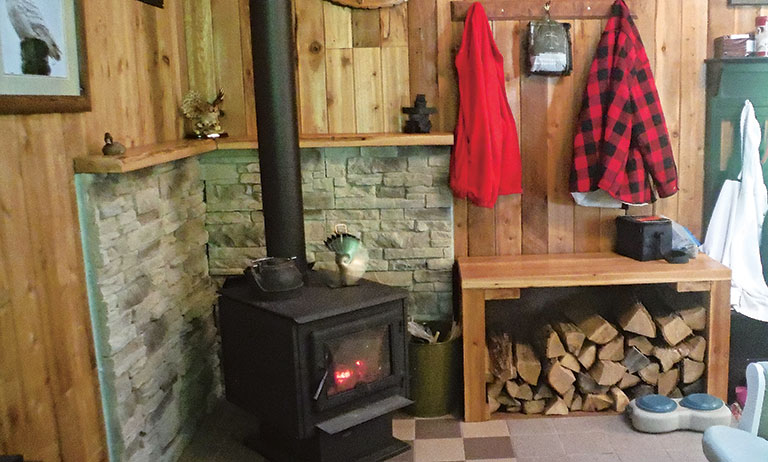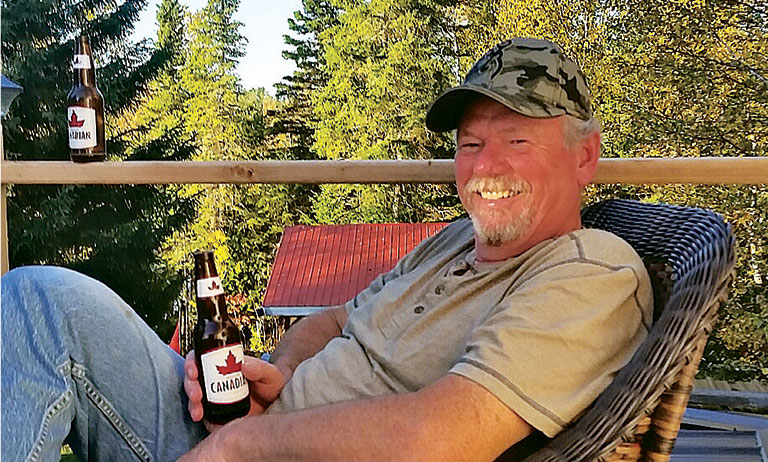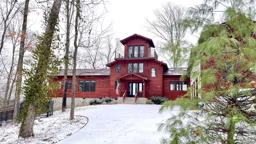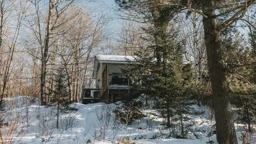
This family cabin in Northern Ontario is a year-round, off-grid treasure, but they debated getting a cell phone service booster to make it truly remote.
Flo and Frank DeJonge staked their claim in July 2014. And we’re not talking about the Hemlo gold mines where Frank works. No, this treasure was discovered a few miles east of Hemlo, on the shores of Cedar Lake in Ontario. For years, the couple had searched for a retreat close to home in Marathon, Ontario. As soon as they saw this property, says Frank, they knew it was the right one. The nearly two-acre lot is adjacent to crown (public) land. The property came with a small off-grid cabin, plus a mother lode of materials left over from the cabin’s construction in the late 1970s-early 80s. Since the site has lake access only, Flo and Frank removed boatloads of debris and stoked many a giant campfire.
See also A Special Family Cabin on a Minnesota Island Also, the hardworking couple, along with other cottage owners, have cleared a few trails into the crown lands, notes Flo.

4-Season fun at the Cabin
The DeJonge Family Camp is used mainly in summer, since the cabin is not properly winterized. “We do go in winter but find that we burn a lot of wood,” says Flo. At that time of year, they snowmobile in to go ice fishing and snowshoeing. As soon as the lake thaws in spring, they arrive by motorboat – a three-minute ride from the landing. (To bring along 4-wheelers and other large items, the DeJonges attach a 20x6-foot floating dock to the boat.) The couple is often joined by their son and his wife, as well as their daughter and her boyfriend. All share a passion for fishing, boating and a range of water sports on Cedar Lake. Flo’s favorite activity is kayaking at sunrise, when she’s the only one on the calm lake. “It’s the most humbling feeling in the world,” she says. In the fall, Frank rides his 4-wheeler in the woods and hunts partridge. However, September is Flo’s favorite time of year at camp. “No bugs, fresh air, the summer work is done and the garden is mainly picked,” she says with satisfaction. “It is fully relax time!”

Off-Grid Amenity Updates
Built in the late 1970s to early 80s, the cabin measures 15x20 feet with a living room, kitchen, and a loft with two bedrooms. An addition features a sauna and bedroom with a shower. Frank installed a hot water on-demand system to replace the original water tank that was inside the sauna. “You’d have to fire up the sauna to get hot water,” he says. Though off-grid, the DeJonges enjoy all the comforts of home. Last year they updated the solar energy system, installing a PV panel (265-watt, 24-volt, 60-cell polycrystalline) and four Trojan 6-volt deep cycle batteries for energy storage. Solar power runs all the LED lighting inside and on the porch. There are about 15 fixtures now, up from the original two. “One of the first things I did was upgrade the lighting,” recalls Frank. Solar power also runs a cell phone booster and a water pump. A cistern on the roof holds the water pumped from the lake. The water is gravity-fed to the sink, and Javex (Clorox household bleach) is added to eliminate any bacteria and algae. The water is boiled to rinse the dishes. The DeJonges bring bottled water for drinking. A well under the back porch supplies clear water for gardening. The property has an outhouse along with an RV chemical toilet in the cabin’s upstairs for nighttime convenience. In the kitchen, a new EZ Freeze refrigerator and a Premier range run on propane, as does the on-demand water heater mounted outside. Frank can follow the Toronto Maple Leafs on the 40-inch flat screen; the TV works either on solar or a virtually silent portable Yamaha generator on rainy days. But you won’t find either Frank or Flo sitting for long.
See also The Affordable Log Cabin 
On the Move
Since buying the property, the couple has made numerous improvements to the interior and exterior, along with a tremendous amount of landscaping. “We’re always painting or doing projects,” says Flo. They made all the kitchen cupboards and counters and laid vinyl flooring that can handle water and two dogs. Recently, they made a sliding barn door with cedar boards from the farmhouse where Flo was born. The door is destined for the loft master bedroom. The couple’s adjustments have upped the cabin’s comfort factor and helped to make it feel like their own. “With a few more years, we think we’ll be happy with the result, and ready to retire in it, says Flo.”
Cell Phone Service Boosters
Owning a cabin in a remote area often means limited cell phone signal. A signal booster, like the one at this retreat, is a great way to get better reception. Without the cell phone booster, the DeJonges had only one bar out of five that indicates the decibels of power being received from a cell phone tower. With the booster, they get three or four bars and have Internet through the phone. Still, it wasn’t an easy decision to install the booster. “It’s something we hemmed and hawed about,” says Flo, “because we’re going to camp to get away from all that. But especially that first year, when we were planning, it was nice to have a cell phone to do research.” Boosters work for all cell phone carriers, all devices, and boost 2G, 3G and 4G LTE signals. The easy-to-install kit is a one-time purchase, so there are no monthly or recurring fees. The only drawback is that boosters can’t create cellular signal, they can only boost it. So, there must be enough working signal to amplify. (As this varies between carriers, you may want to use the Field Test Mode on your phone to see what the decibel reading is at your cabin.)














